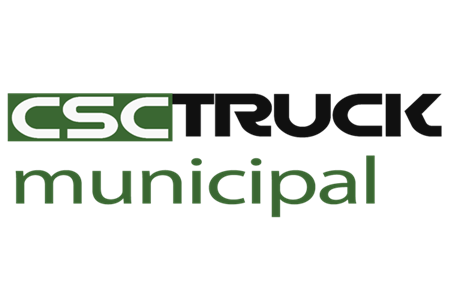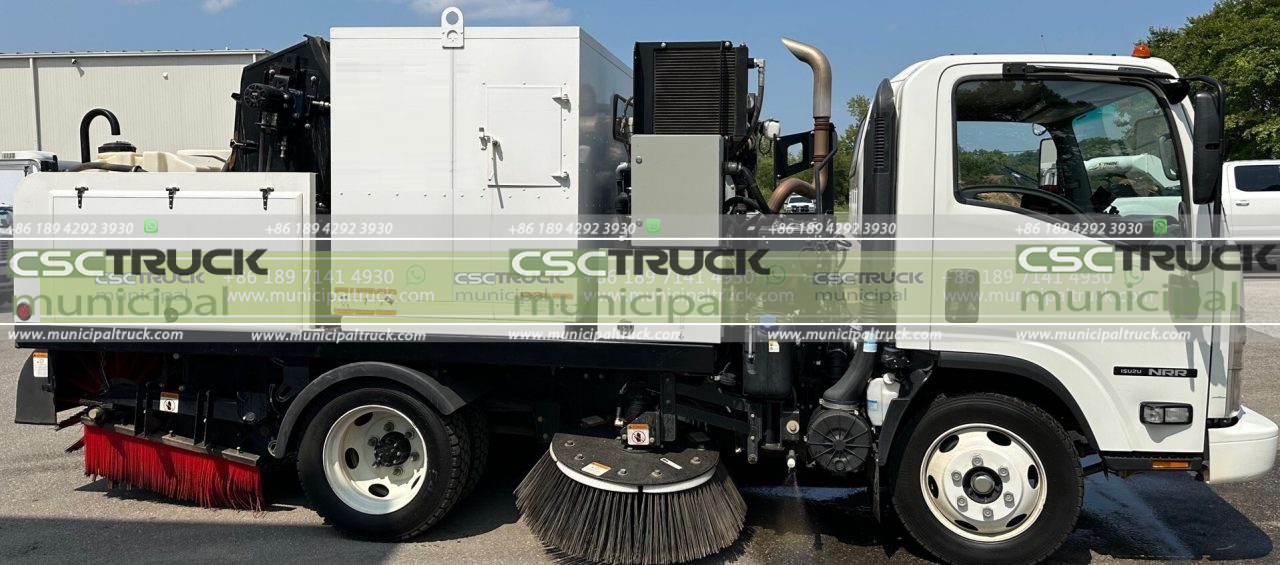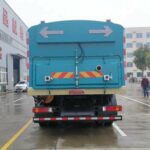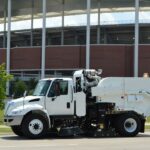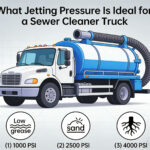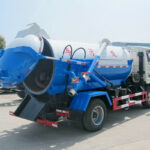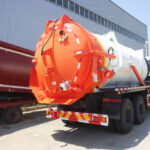1. Operational Synergy: The Dual-Action Cleaning Paradigm
Merging Hydro-Kinetic Force with Mechanical Precision
The emergence of combined sweeper jetter trucks represents a quantum leap in municipal sanitation, integrating ultra-high-pressure water jetting (operating at 25,000-40,000 PSI) with negative-airflow debris recovery systems within a single mobile platform. This convergence enables simultaneous contaminant dislodgement and capture – a capability previously requiring three separate vehicles and crew deployments. The operational sequence unfolds through a choreographed mechanical ballet: high-velocity water arrays first fracture bonded residues through cavitation erosion, while precisely calibrated vacuum ducts immediately entrain the liberated particulates before resettlement occurs. During the 2024 Singapore National Day Parade preparations, these units cleaned 18km of ceremonial routes in a single overnight shift, removing 4.3 tons of chewing gum, grease, and atmospheric fallout particles with 92% water recovery rates. The continuous workflow integration eliminates the critical vulnerability window in traditional cleaning – the dangerous minutes when pathogens become aerosolized between washing and collection phases.
2. Technological Architecture: Engineering the Unification
Hydro-Dynamic Contaminant Targeting
Intelligent nozzle arrays transcend conventional spraying through:
- Variable Spectrum Jetting: Automatically shifting between 15° fan jets for surface biofilms and 0° piercing streams for crack-embedded contaminants
- Thermo-Regulated Cleaning: Heating circuits maintaining water at 80°C for lipid dissolution in food districts, switching to 4°C for gum removal in pedestrian zones
- Abrasive Modulation Systems: Onboard garnet media injectors activating only when detecting calcified deposits exceeding Mohs 3 hardness
Cyber-Physical Debris Management
The AI-driven recovery ecosystem features:
- LIDAR-Assisted Vacuum Optimization: Dynamically adjusting suction power (3-28 kPa) based on real-time debris density mapping
- Pathogen-Neutralizing Filtration: Five-stage HEPA systems incorporating UV-C irradiation and electrostatic precipitation chambers
- Autonomous Route Learning: Machine vision systems identifying recurrent contamination patterns along service corridors
Seoul’s fleet demonstrated this during norovirus outbreaks, where onboard qPCR analyzers detected pathogen hotspots and automatically increased sodium hypochlorite concentration in jetting streams while vacuum isolators contained infectious aerosols – reducing decontamination cycles from 72 hours to immediate resolution.
3. Environmental & Economic Calculus
The Sustainability Matrix
Combined sweeper jetter trucks deliver compounding benefits through resource circularity:
- Water Reclamation Engineering
Advanced units recycle 87-94% of operational water via:- Lamella Clarifiers: Removing suspended solids >50 microns
- Dissolved Air Flotation: Extracting emulsified oils and hydrocarbons
- Electrodeionization: Achieving 10µS/cm purity for reuse
- Carbon-Neutral Operation
Hybrid powertrains leverage regenerative hydraulic braking to power jetting pumps, while waste-derived biofuels from recovered organics offset 63% of fleet emissions in Copenhagen’s pilot program. - Lifecycle Cost Revolution
The unification slashes operational expenditures through:Parameter Traditional Fleet Combined Units Fuel Consumption 38 L/km 14 L/km Labor Requirements 9 crew/3 vehicles 2 crew/1 vehicle Road Occupation 11.3 lane-meters 4.2 lane-meters
Los Angeles documented 27% faster emergency response during mudflow events, where combined units cleared debris while simultaneously disinfecting contaminated zones – avoiding $380,000/hour in commerce disruption costs per corridor.
4. Municipal Integration: The Smart City Backbone
Ecosystem Interoperability
Forward-thinking municipalities now position combined sweeper jetter trucks as central nervous system nodes within broader urban hygiene networks:
- Data Fusion Platforms: Onboard sensors feed contamination maps to digital twin systems, enabling predictive cleaning before citizen reports emerge
- Multi-Agent Collaboration: Units automatically summon robotic gutter cleaners when detecting subsurface blockages beyond hydraulic reach
- Disaster Response Protocols: Configurations switch to crisis decontamination mode during flooding events, jetting disinfectants while extracting hazardous debris
The true transformation emerges when integrated with complementary assets: - Pre-cleaning soil conditioning via water sprinkler trucks with surfactant infusion systems
- Post-sanitization verification through autonomous swab robots deployed from sweeper truck docking bays
- Fleet-wide intelligence sharing across IoT-enabled municipal truck ecosystems using 5G mesh networks
Amsterdam’s “Schoon Amstel” initiative exemplifies this evolution – their combined units now serve as mobile water quality laboratories, analyzing street-level runoff in real-time while cleaning. As sensors detect phosphate spikes from illegal detergent discharge, the system automatically traces pollution sources through AI-powered flow modeling, simultaneously notifying inspectors and adjusting jetting chemistry to neutralize environmental damage. This represents the new paradigm: no longer merely cleaning streets, but actively healing the urban metabolism through every pass.
